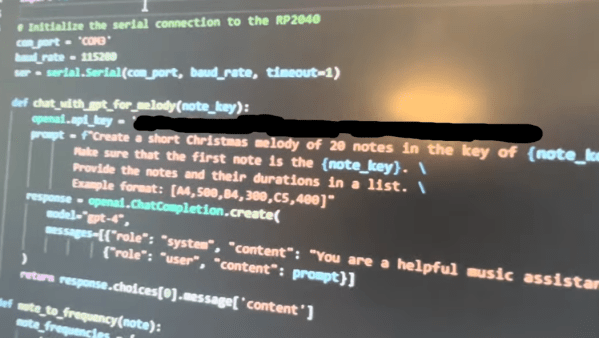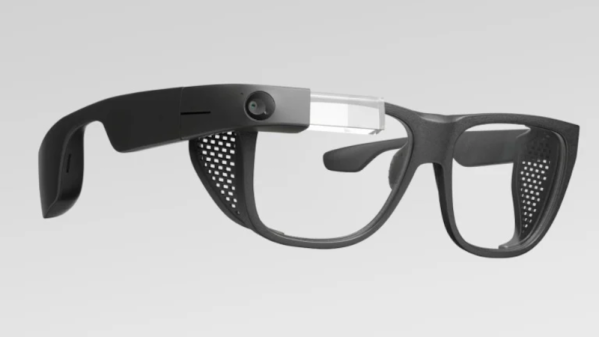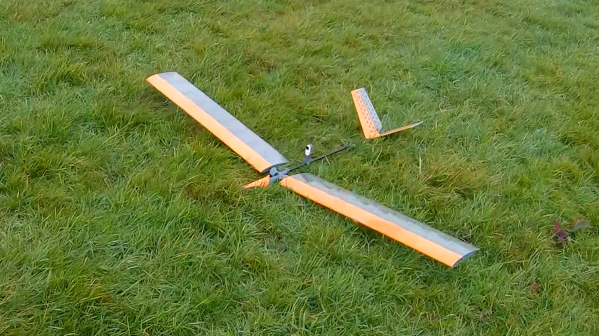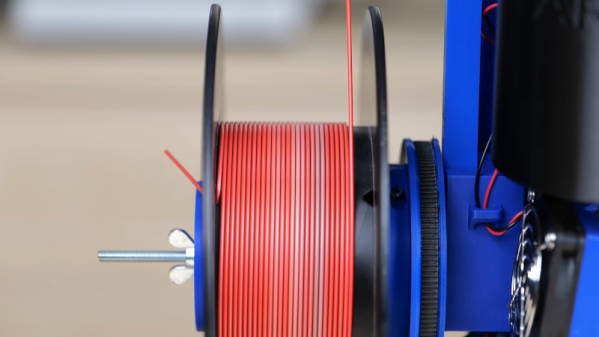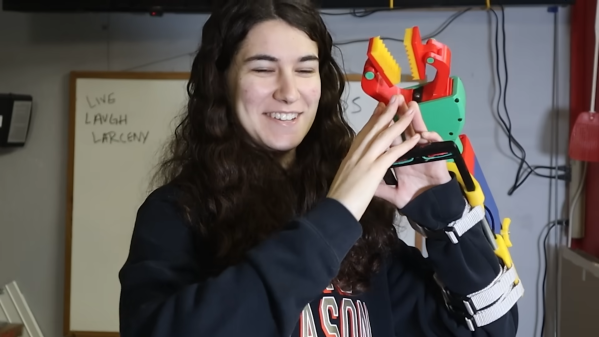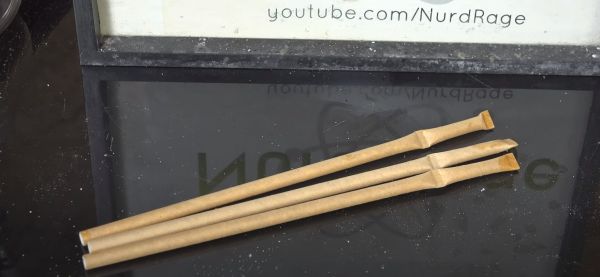If you were to talk about sixteen bit computing in retrocomputing circles, misty-eyed reminiscences of the ST or Amiga would emerge. Both fine platforms, but oddly the elephant in the 16-bit room has become a victim of its own success. DOS, the granddaddy of all PC operating systems, seems oddly overshadowed by its 68000-based competitors in a way it certainly wasn’t back in the day. Perhaps it’s the often-atrocious graphics when cards designed for business graphics were pressed into gaming service, but it’s easy to forget that DOS PCs were the powerhouses of their day. They still pack a punch even in 2023, as [Lunduke] is here to show us by running a DOS web server. Take that, nginx! Continue reading “A Web Server, The Sixteen Bit Way”
Day: December 25, 2023
Audio Synthesizer Hooked Up With ChatGPT Interface
ChatGPT is being asked to handle all kinds of weird tasks, from determining whether written text was created by an AI, to answering homework questions, and much more. It’s good at some of these tasks, and absolutely incapable of others. [Filipe dos Santos Branco] and [Edward Gu] had an out of the box idea, though. What if ChatGPT could do something musical?
They built a system that, at the press of a button, would query ChatGPT for a 10-note melody in a given musical key. Once the note sequence is generated by the large language model, it’s played out by a PWM-based synthesizer running on a Raspberry Pi Pico.
Ultimately, ChatGPT is no musical genius. It’s simply picking a bunch of notes from a list that are known to work together melodically; that’s the whole point of musical keys. It would have been wild if it generated some riffs on the level of Stairway to Heaven or Spontaneous Devotion, but that might be asking for too much.
Here’s the question, though. If you trained a large language model, but got it to digest sheet music instead of written texts… could it learn to write music in various genres and styles? If someone isn’t working on that already, there’s surely an entire PhD you could get out of that idea alone. We should talk!
In any case, it’s one of the more creative projects from the ever-popular ECE 4760 class at Cornell. We’ve featured a bunch of projects from the class over the years, and noted how the course now runs on the RP2040. Continue reading “Audio Synthesizer Hooked Up With ChatGPT Interface”
The Tech That Died In 2023
We don’t indulge too often in looking back, but [Chloe Albanesisu] at PC Magazine did and wrote the tech obituary for all the tech gadgets and services that died over this past year. Some of the entries are a bit predictable: Twitter died to be replaced by X, which is exactly like it, only different. Others we hardly noticed, like Netflix stopping its DVD shipments.
Google Glass died again, but this time it was the enterprise edition. Amazon gave up on both donating money through shopping and print subscriptions via Kindle.
Glass wasn’t the only Google casualty. Gmail lost its basic HTML version and shut down its smart whiteboard product, Jamboard. They also sold off their Internet domain business in an effort to focus on core businesses. Other notable Google shutdowns include their popular podcast app and Usenet support for Groups. Oh, and don’t forget their experiment in offering Pixels phones as a subscription. That’s done, too.
As you might expect, PC Magazine’s list is a bit consumer-oriented. What hacker-centric products and services vanished this year that you’ll miss? The Sculpteo Marketplace? XYZ Printing? Start up companies collapsed in 2023 at an alarming rate, but you didn’t hear about most of them. Were there any you were especially disappointed about? Let us know in the comments.
Building A Rad Super Capacitor RC Plane
[Tom Stanton] is a fan of things like rubber band planes, and has built many of his own air-powered models over the years. Now, he’s built a model powered by a supercapacitor for a thoroughly modern twist on stored-energy flying toys.
It’s not a wholly original idea; [Tom] was inspired by a toy he bought off-the-shelf. His idea, though, was to make one that could be hand-cranked to charge it to make it more like the rubber-band planes of old. He thus built his own geared generator for the job using a big pile of magnets and 3D printed components. It’s capable of putting out around 17 volts when cranked at a reasonable speed. Hooked up to the toy plane, his hand-crank generator was able to fully charge the plane in just a few turns.
His generator was really overkill for the small toy, though. Thus, he elected to build himself a much larger supercapacitor-powered model. He wired up a pack of six supercapacitors in series, designed for roughly 18 volts. The pack was given balance leads to ensure that no individual capacitor was charged beyond its 3.0 V rating. The pack was placed inside a nice aerodynamic printed fuselage. The plane was then given a brushless motor and prop, speed controller, servos, and an RC receiver. Indeed, far from a simple throwable model, it’s a fully flyable RC plane.
The plane is quite a capable flyer with plenty of power, but a fairly short run time of just under two minutes. Though, with that said, it can be recharged in just about that same amount of time thanks to its supercapacitor power supply. [Tom] reckons it should be capable of a 1:1 crank time to flight time ratio in ideal conditions.
Supercapacitors are super cool, but we don’t see enough of them. They’ve popped up here and there, and obviously have many important applications, but we’re not sure they’ve had a real killer app in the consumer space. XV Racers were killer fun, though. Continue reading “Building A Rad Super Capacitor RC Plane”
3D Printing With Plastic Cutlery
How many plastic spoons, knives, and forks do you think we throw away daily? [Stefan] noted that the compostable type is made from PLA, so why shouldn’t you be able to recycle it into 3D printing stock? How did it work? Check it out in the video below.
[Stefan] already has a nice setup for extruding filament. However, unsurprisingly, it won’t accept spoons and forks directly. A blender didn’t help, so he used an industrial plastic shredder. It reduced the utensils to what looked like coarse dust, which he then dried out. After running it through the extruder, the resulting filament was thin and brittle. [Stefan] speculates the plastic was set up for injection molding, but it at least showed the concept had merit.
In a second attempt, he cut the ground-up utensils with fresh PLA in equal measures. That is, 50% of the mix was recycled, and half was not. That made much more usable filament. So did a different brand of compostable plasticware.
The real test was to take dirty plasticware. This time, he soaked utensils in tomato sauce overnight. He cleaned, dried, and shredded the plastic. This time, he used 20% new PLA and some pigment, as well. We aren’t sure this is worth the effort simply on economics, but if you are committed to recycling, this might be worth your while.
It always seems like it should be easy to extrude filament. Until you try to do it, of course. Recycling plastic bottles is especially popular.
Is This 3D Printed Third Arm Useful? Maybe?
Humans have two arms, and we do pretty good things with them. More is surely better, though, right? With that in mind, [Emily The Engineer] set out to make a third arm for popular YouTuber [This Old Tony], and our primary question is this: is it actually useful?
The basic design is based around a strapped-on arm brace, which mounts the additional appendage to the wearer’s forearm. It uses a motor-driven geared mechanism to open and close a gripper, but the first revision was incredibly slow to open and close, to the point of being almost useless. Changing out the threaded rod that drives the mechanism massively sped up the gripper, much to [Emily]’s satisfaction. Strength and mounting upgrades got it to the point where it could actually be used to lift objects like spray cans and bricks. Ultimately, though, the arm mount and controls do kind of prevent the user from using their left hand when they have the third hand fitted.
It’s a fun project, if not exactly a useful one, even if [Emily] does use it to carry extra grocery bags . It does have us wondering if some kind of shoulder or backpack-mounted arms could be useful, though. It’s certainly not up to the standards of modern prosthetic, but we do love the idea of human augmentation with additional robot limbs. Here’s hoping technology advances further to make builds like this more capable in future!
Continue reading “Is This 3D Printed Third Arm Useful? Maybe?”
Promethean Matches: The Ancestor To Modern Matches
The history of making fire at will is a long and storied one, stretching back to the days when we’d rub wooden sticks together, or use flint and steel to ignite tinder. An easier, albeit vastly more expensive and dangerous alternative came in the 19th century when chemists discovered auto-ignition using a potassium chlorate mixture and sulfuric acid. This method was refined and later patented by Samuel Jones in 1828 as the ‘promethean match’ after the God of Fire, Prometheus, which is the topic of a recent [NurdRage] chemistry video.

Using practically the same recipe of potassium chlorate and sugar as in the 19th century, [NurdRage] uses paper straws to contain this powder. Glue is used to section the paper straw into two compartments and seal in the components, with the smaller compartment used for a glass capsule containing sulfuric acid. This vial was produced from the tip of a glass pipette, using a hot flame to first seal the tip, then detach and seal the other end of the tip, resulting in the sulfuric acid capsule, ready to be added to the second compartment.
The moment this glass capsule is crushed, the sulfuric acid will soak into the paper, reaching the large compartment with the potassium chlorate and sugar mixture, causing a strongly exothermic reaction that ignites the paper. Yet as simple as this sounds, [NurdRage] found the three matches he made to be rather fickle, with one igniting beautifully after crushing the capsule with pliers, while one did nothing and the remaining match decided to violently explode rather than burn.
Considering the immense manual labor involved in making these matches, they never were very popular, and were quickly replaced by strike-anywhere matches, followed by safety matches, none of which require you to carry fragile glass capsules containing sulfuric acid with you. As a chemistry experiment, it is however a total blast that will set any boring chemistry class on fire.
Continue reading “Promethean Matches: The Ancestor To Modern Matches”


